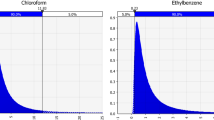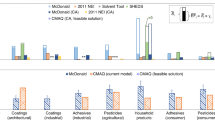Abstract
Accurate modeling of exposure to volatile organic compounds (VOCs) over a large study population depends on proper characterization of concentrations in the indoor residential environment. However, owing to the high expense of field sampling campaigns for determining indoor air concentrations, such studies have only been conducted for limited populations. Therefore, there is a need to determine the degree to which results can be extrapolated to unstudied settings through the use of models, the most appropriate information required to do so and the potential errors associated with the use of sub-optimal information. The goal of this analysis is to evaluate three different source indicators used to predict indoor VOC concentration distributions for a new study population. Data from two field studies are used. For each data set, source strength, indoor–outdoor (I–O) difference and indoor/outdoor (I/O) ratio, collectively referred to as source indicators, are calculated and fit with distributions. These distributions, as well as distributions for air exchange, volume and outdoor concentrations for the new study population, are used for predicting indoor concentrations using Monte Carlo simulations, which are then compared with actual distributions. As expected, the source strength often provides the most effective predictions (11 out of 20 instances), but is slightly outperformed by, although is still comparable with, the I–O difference on some occasions (4 out of 20). The I/O ratio generally has the greatest prediction errors, given its dependence on outdoor concentrations, but performs optimally in a limited number of cases (5 out of 20). When deciding between the source strength and I–O difference, one must consider the availability and fidelity of both current and future data. On the basis of our findings, exposure-monitoring studies should report the distribution statistics for I–O differences and, if the data are available, for source strengths.
This is a preview of subscription content, access via your institution
Access options
Subscribe to this journal
Receive 6 print issues and online access
$259.00 per year
only $43.17 per issue
Buy this article
- Purchase on Springer Link
- Instant access to full article PDF
Prices may be subject to local taxes which are calculated during checkout



Similar content being viewed by others
References
Adgate J.L., et al. Outdoor, indoor, and personal exposure to VOCs in children. Environ Health Perspect 2004a: 112: 1386–1392.
Adgate J.L., Eberly L.E., Stroebel C., Pellizzari E.D., and Sexton K. Personal, indoor, and outdoor VOC exposures in a probability sample of children. J Expo Anal Environ Epidemiol 2004b: 14: S4–S13.
Clayton C.A., Pellizzari E.D., Whitmore R.W., Perritt R.L., and Quackenboss J.J. National Human Exposure Assessment Survey (NHEXAS): distributions and associations of lead, arsenic and volatile organic compounds in EPA Region 5. J Expo Anal Environ Epidemiol 1999: 9: 381–392.
Conover W.J. Practical Nonparametric Statistics. John Wiley & Sons, New York, 1971.
Dietz R.N., Goodrich R.W., Cote E. and Wieser R. Detailed description and performance of a passive perflourocarbon tracer system for building ventilation and air exchange measurements. In: H. Trechsel and P. Lagus. Measure Air Leakage of Buildings, ASTM STP 904. American Society for Testing Materials, Philladelphia, PA, 1986.
Dodson R.E., Houseman E.A., Levy J.I., Spengler J., Shine J.P., and Bennett D.H. Measured and modeled personal exposures and risks to volatile organic compounds. Environ Sci Technol 2007a: 41: 8498–8505.
Dodson R.E., Levy J.I., Shine J.P., Spengler J.D., and Bennett D.H. Multi-zonal air flow rates in residences in Boston, Massachusetts. Atmos Environ 2007b: 41: 3722–3727.
Dodson R.E., Levy J.I., Spengler J.D., Shine J.P., and Bennett D.H. Influence of basements, garages, and common hallways on indoor residential volatile organic compounds concentrations. Atmos Environ 2008: 42: 1569–1581.
Edwards R.D., Jurvelin J., Saarela K., and Jantunen M. VOC concentrations measured in personal samples and residential indoor, outdoor and workplace microenvironments in EXPOLIS-Helsinki, Finland. Atmos Environ 2001: 35: 4531–4543.
Finlayson-Pitts B.J., and Pitts Jr, J.N. Atmospheric Chemistry: Fundamentals and Experimental Techniques. John Wiley & Sons, New York, 1986.
Gordon S., et al. Residential environmental measures in the National Human Exposure Assessment Survey (NHEXAS) pilot study in Arizona: preliminary results for pesticides and VOCs. J Expo Anal Environ Epidemiol 1999: 9: 456–470.
Graham L.A., Noseworthy L., Fugler D., O’Leary K., Karman D., and Grande C. Contribution of vehicle emissions from an attached garage to residential indoor air pollution levels. J Air Waste Manage Assoc 2004: 54: 563–584.
Kinney P.L., Chillrud S.N., Ramstrom S., Ross J., and Spengler J.D. Exposures to multiple air toxics in New York City. Environ Health Perspect 2002: 110: 539–546.
Lewis C.W. Sources of air pollutants indoors: VOC and fine particulate species. J Expos Anal Environ Epidemiol 1991: 1: 31–44.
Liu W., et al. Estimating contributions of indoor and outdoor sources to indoor carbonyl concentrations in three urban areas of the United States. Atmos Environ 2006: 40: 2002–2214.
Loh M., Levy J.I., Spengler J.D., Houseman E.A., and Bennett D.H. Ranking cancer risks of organic hazardous air pollutants in the United States. Environ Health Perspect 2007: 115: 1160–1168.
Murray D.M., and Burmaster D.E. Residential air exchange rates in the United States - empirical and estimated parametric distributions by season and climatic region. Risk Anal 1995: 15: 459–465.
Sax S.N., Bennett D.H., Chillrud S.N., Kinney P.L., and Spengler J.D. Differences in source emission rates of volatile organic compounds in inner-city residences of New York City and Los Angeles. J Expo Anal Environ Epidemiol 2004: 14 (Suppl 1): S95–109.
Sax S.N., Bennett D.H., Chillrud S.N., Ross J., Kinney P.L., and Spengler J.D. A cancer risk assessment of inner-city teenagers living in New York City and Los Angeles. Environ Health Perspect 2006: 114: 1558–1566.
Sexton K., et al. Evaluating differences between measured personal exposures to volatile organic compounds and concentrations in outdoor and indoor air. Environ Sci Technol 2004a: 38: 2593–2602.
Sexton K., et al. Comparison of personal, indoor, and outdoor exposures to hazardous air pollutants in three urban communities. Environ Sci Technol 2004b: 38: 423–430.
Tancrede M., Wilson R., Zeise L., and Crouch E.A.C. The carcinogenic risk of some organic vapors indoors: a theoretical survey. Atmos Environ 1987: 21: 2187–2205.
US Environmental Protection Agency. Exposure Factors Handbook. US EPA, Office of Research and Development, National Center for Environmental Assessment. Washington, DC 1997, EPA/600/P-95/002.
Wallace L.A. Comparison of risks from outdoor and indoor exposure to toxic chemicals. Environ Health Perspect 1991: 95: 7–13.
Wallace L.A. Human exposure to volatile organic pollutants: implications for indoor air studies. Annu Rev Energy Environ 2001: 26: 269–301.
Willbury W.T., Tejada S., Lonneman W., and Kleinndienst E. Compedium Method TO-11A: Determination of formaldehyde in ambient air using adsorbent followed by High Performance Liquid Chromotography (HPLC) (Active sampling methodology). US Environmental Protection Agency. Cincinnati, OH 1999, EPA/625/R-96/010b.
Winberry W.T., Forehand L., Murphy N.T., Ceroli A., and Phinney B. Compendium of methods for the determination of air pollutants in indoor air. US Environmental Protection Agency. Research Triangle Park, NC 1990 EPA/600/4-90/010.
Woolfenden E.A., and McClenny W.A. Compendium Method TO-17: Determination of volatile organic compounds in ambient air using active sampling onto sorbent tubes. Cincinnati, OH. US Environmental Protection Agency, 1997 EPA/625/R-96/010b.
Zhang J., He Q., and Lioy P.J. Characteristics of aldehydes: concentrations, sources, and exposures for indoor and outdoor residential microenvironments. Environ Sci Technol 1994: 28: 146–152.
Acknowledgements
This analysis and the BEAM Study were funded by the American Chemistry Council and the ISEA Young Investigator's Award (Deborah Bennett). Laboratory analyses were partially funded by the Harvard NIEHS Center for Environmental Health (Grant No. P30ES00002). The authors thank the study participants in both studies for letting them into their residences, as well as the field and laboratory staff.
Author information
Authors and Affiliations
Corresponding author
Additional information
Supplementary Information accompanies the paper on the Journal of Exposure Analysis and Environmental Epidemiology website (http://www.nature.com/jes)
Supplementary information
Rights and permissions
About this article
Cite this article
Dodson, R., Levy, J., Houseman, E. et al. Evaluating methods for predicting indoor residential volatile organic compound concentration distributions. J Expo Sci Environ Epidemiol 19, 682–693 (2009). https://doi.org/10.1038/jes.2009.1
Received:
Accepted:
Published:
Issue Date:
DOI: https://doi.org/10.1038/jes.2009.1
Keywords
This article is cited by
-
Spatiotemporal variability of tetrachloroethylene in residential indoor air due to vapor intrusion: a longitudinal, community-based study
Journal of Exposure Science & Environmental Epidemiology (2014)



